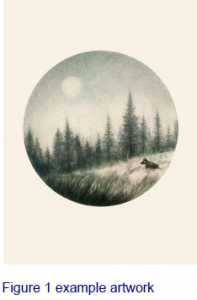Alyssa Scott and Professor Robert Barrett, Illustration Department
The purpose of this project was to explore some of the new possibilities artists have to display artwork and tell stories by creating an interactive, multi-ending ebook. With new technology becoming more accessible every day, the digital medium has become a relevant way to get quality art and messages into people’s hands. By using this technology, I sought to create a type of story that the reader could interact with and give readers the opportunity to choose their own path and explore different storylines.
The initial challenge was to find the right story that would work in this format. Starting from scratch would take too long, but any story would have to be modified to have multiple endings and storylines. This was a bigger undertaking than I anticipated but after searching through the public domain, I found a story I loved called “The Moonstone” by Wilkie Collins. “The Moonstone” was published in 1868 and is known as one of the very first detective novels. It is about a cursed diamond that goes missing and mysterious things start to happen to those around the stone . Using this storyline as a starting point, I started to storyboard out the different paths that readers would be able to choose between. Then I picked my favorite scenes to start illustrating first (see fig. 1 and 3 for examples of this artwork).
I set up an exhibition featuring some of this work, which was shown in the HFAC from June 3rd to June 14th, 2013. In addition to creating the artwork, I collaborated with a music student, who created 8 original compositions that could serve as the story’s soundtrack. Next, I started preparing my story to take shape as a published app.
In the final stage of development, I ran into more challenges. After researching the ebook market, I started to realize I did not have enough content yet to appeal to my target audience of teens and young adults. When thinking about my options, I found there were other ways to show my art and story. I decided to first display my ebook in the form of a website. While the website is up, I can build up and add more artwork and story as I go along, much like how webcomics are set up. Then in the future, I can pursue a more formal publication. I have found that I actually like this platform better than my original plan. Now my project is freely accessible for anyone to see, whereas before they would be limited to those with tablets who could get it from the app store. A website is also a good test to gauge the interest and demand of a story like this. The first pages of my project are up at www.curseofthemoonstone.com, while more pages are still in production (see fig.2 for website homepage).
By creating this interactive story, I have learned a few things that would be helpful to anyone interested in starting a similar project. First, collaboration is powerful. What I envisioned for my final product should have taken a bigger team to create. Dedicating so much time to other elements like story and publication cut down on the art production time. If I were to do a project like this again I would team up with more people, and designate an art director to manage the project.
I also learned it is best to start simply and expand from there, especially for the first ebook. When planning out the multiple endings for my story, I found that all the possibilities started to complicate the project really quickly. Cutting out elements that did not enhance the story was helpful in saving time and not distracting from the core of the book.
By creating this project, I found that digital mediums like ebooks are a great place to give old stories new life. Taking a novel from 1868 and giving it a modern twist was an exciting challenge that I think will make it more accessible for a new generation. Interactive stories have great potential as a new artistic medium. The new digital world creates more room for visual storytelling, and lets people view illustrations with the touch of a button. Now it is up to artists to explore the new territory.



